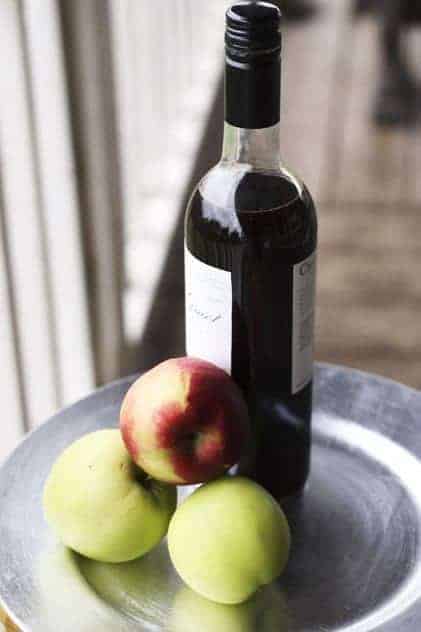
Boiled Cider is the pure essence of apple and everything wonderful about fall condensed into one syrup. And it’s ridiculously easy to make!
I am a magician. You see that wine bottle? I fit two whole gallons of apple cider into it.
Really. Okay, I boiled the cider down until it fit, and I didn’t have to work hard to do it.
Yes, it took nearly six hours, but I didn’t stir it and wasn’t even in the same room (or same floor of the house for that matter) for more time than it took to pop in and confirm that, yeah, it was still boiling, and mmm-hmmm, it was still shrinking in volume.
So what’s the point behind this exercise? I am about to let you in on an almost-forgotten little piece of America’s food history. This thing goes all the way back to the sixteen-hundreds, the introduction of apples as a crop and the European settlers.
I’m talking about Boiled Cider. Oh, I know. The name? Boring. Totally.
Sometimes it has been referred to as apple molasses which, while a little more jazzed up comparatively speaking, still sounds pretty meh. Believe me, though, there is nothing bland, boring, or unexciting about Boiled Cider.
You know when you get a really good glass of fresh, icy cold apple cider straight from the mill; The way your tastebuds perk up and your mouth actually waters from the tart sweet cider? Imagine that times seven.
Seven is not an arbitrary choice for this comparison. When boiling cider down for this project you want to reduce it to one seventh of its original volume.
Add to that a hint of caramelization, and a thick, pancake syrupy consistency and you have Boiled Cider. It is beautiful in its simplicity.
It is just cider. No sugar, no flavourings, no preservatives, no fancy canning.
It is only cider boiled down into a thick, shelf-stable syrup that makes just about everything better by its mere presence. There is no added sugar, it is the natural sweetness of the apples that makes this so good.
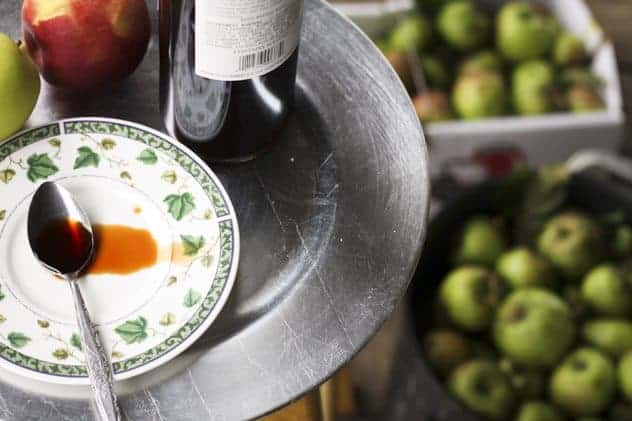
Boiled Cider started as a way the settlers devised to preserve cider long past when even hard cider would be drinkable and would pass into irretrievably vinegar territory. Kept in a bottle on the pantry shelf, this stuff lasted through the winter and into the next apple season for them and it will do the same for you.
What do you do with Boiled Cider? Let me get you started, but once you have this handy, you’ll be off and running.
Drizzle over vanilla ice cream. It’s amazing.
Use to baste pork roasts or chops, ham, chicken or glaze other meats. You’ll wonder what you did without it.
Stir a little into hot tea. It’s instant fall in a mug!
Pour some into a mug, add a shot of whiskey or brandy, and top off with hot water. You will be so pleased with yourself it’ll be indecent.
Toss a tablespoon or two to the sliced apples for a pie or apple crisp. You will be blown away by how much more apple-y it tastes. (I know many professional bakers add this to their pies and crisps as their secret ingredient!)
Whisk into cream cheese icing for a pumpkin spice cake and be prepared for the compliments. Also, be prepared to make more because it’ll go fast.
…Our personal favourite: Pour a tablespoon over ice, fill the rest of the glass with seltzer water, and give a quick stir. Voila! Healthy apple cider soda!
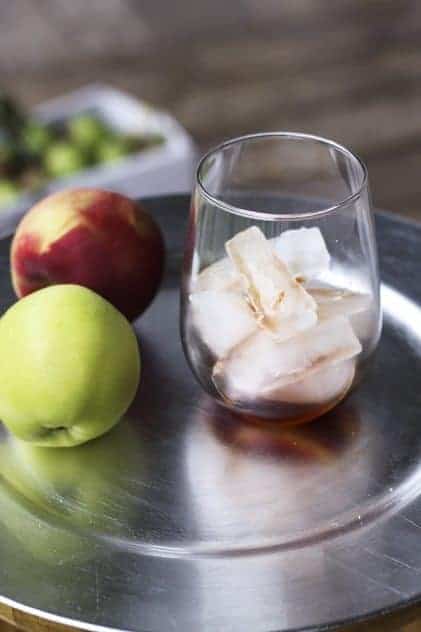
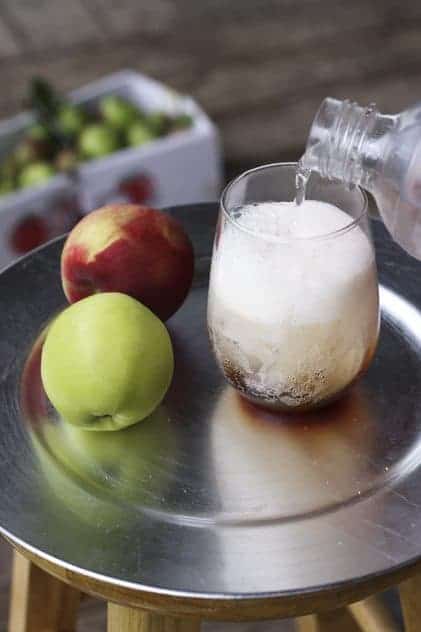
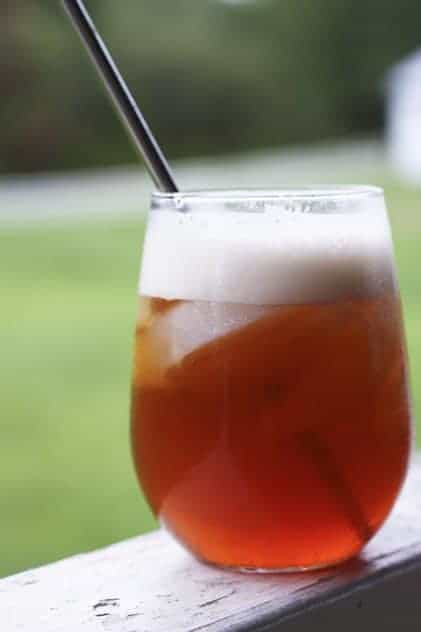
Lipsmacking just doesn’t cover it. This is… It’s… Could words be failing me?
It’s like everything wonderful about fall condensed into one syrup. It’s pure, distilled essence of apple. It’s completely and utterly wonderful. And you get all this just by boiling a pot of cider.
Don’t wait. Make some of this for yourself as soon as possible. Have it on your shelf.
Then, in December, January, February -whenever you need a boost- pull out your bottle of this opaque, deep reddish brown elixir and pour out a little measure of happiness. You’ll be so glad you did.
Where can you use this boiled cider? Use it in our Maple Chai Apple Pie, Apple Cider Pulled Pork, and Chai Lattes and Hot Caramel Apple Cider, just to name a few! If you’re looking for warm cider, try out our Best Slow-Cooker Mulled Cider!
Boiled Cider
Pour apple cider into a very large, non-reactive stockpot (stainless steel, copper, or glass, but NOT aluminum unless it’s coated.)
Use a clean ruler or wooden stick that you can mark with the starting level of the cider.
Turn heat to high, cover the pot with a splatter screen (to prevent flies or other insects from dropping into the pot) and bring to a boil.
Boil the cider hard until it has reduced to 1/7th of its original volume. Watch more carefully toward the end because it may creep up higher in the pan as it becomes thicker and bubbles stack up on each other. Turn off the heat and let the bubbles die down to check the depth of the liquid with your ruler or dipstick. You should end up with approximately the volume that it takes to fill a clean, empty 750ml wine bottle.
Pour into a clean, sterile jar or bail-top bottle (for long term storage) or a clean, empty wine bottle (for short term, refrigerated storage). Cover tightly and store in a cool, dark place.

Boiled Cider (Apple Molasses)
Rate RecipeIngredients
- 2 gallons apple cider or less, but remember you will be reducing this to 1/7th of it’s original volume.
Instructions
- Pour apple cider into a very large, non-reactive stockpot (stainless steel, copper, or glass, but NOT aluminum unless it’s coated.)
- Use a clean ruler or wooden stick that you can mark with the starting level of the cider.
- Turn heat to high, cover the pot with a splatter screen (to prevent flies or other insects from dropping into the pot) and bring to a boil.
- Boil the cider hard until it has reduced to 1/7th of its original volume. Watch more carefully toward the end because it may creep up higher in the pan as it becomes thicker and bubbles stack up on each other. Turn off the heat and let the bubbles die down to check the depth of the liquid with your ruler or dipstick. You should end up with approximately the volume that it takes to fill a clean, empty 750ml wine bottle.
- Pour into a clean, sterile jar (for long term storage) or a clean, empty wine bottle (for short term, refrigerated storage). Cover tightly and store in a cool, dark place.
Nutrition
Nutritional information is an estimate and provided to you as a courtesy. You should calculate the nutritional information with the actual ingredients used in your recipe using your preferred nutrition calculator.
did you make this recipe?
Make sure to tag @foodiewithfam on Instagram and #hashtag it #foodiewithfamily so I can check it out!
This post was originally published on September 8th, 2011.



Reader's Thoughts...
KARL E. SPARN, JR. says
Becca; Can this liquid recipe be reduced in a crock-pot—much-like cooking apple butter? I canned a batch of apple butter last week and cooked it on ‘low’ for 24 hours without sticking or burning. We also crushed and pressed several bushels of apples into cider – I would like to try this Rx at the cidery, here on the farm. Please advise.
Rebecca says
Hi there. I don’t imagine it would work extremely well in a slow cooker because the goal is to boil it vigorously enough with an open top to evaporate the bulk of the liquid. 🙂
JoeW says
I made this with 104 oz (0.82 gal), of apple juice and it boiled for 2 hours before it reached a syrupy consistency. It’s very likely that my boiling wasn’t as aggressive as yours. I couldn’t get the image out of my mind of a pot with blackened sugar baked onto the bottom. Came out great, though.
I used a product labeled “apple JUICE” whose only ingredient was unsweetened apple juice, without other ingredients or preservatives. It looked unfiltered. Looking around a bit, it appears that neither the producers nor the internet are consistent in their definitions of juice vs cider.
Definitely worth making.
JoeW says
Forgot to mention that the resulting volume of my syrup is 12.7 oz/375 ml, so about half a wine bottle.
Rebecca says
Thanks so much for taking the time to let me know you love it, Joe!
Aidan McKeown says
Hi there – recipe sounds lovely. What is the potential problem with making it in an aluminium saucepan?
Thanks
Aidan
Rebecca says
Hi Aidan! The issue with an aluminum saucepan is that aluminum is reactive. What this means in layman’s terms is that the acid in the apple cider might react with the aluminum and produce tastes or colours that are off or undesirable. It can actually make food have an oddly metallic taste. Great question! Thanks for asking it!
PattiAnn says
Hi Rebecca,
Thinking about doing this boiled cider in the Instant Pot.
What do you think?
Thanks
Emilie Bruno says
When does it start to get thick? I am boiling away and getting close to the 7 mark and it is still the same consistency. as when I started.
Rebecca says
Hi Emilie- 7 mark? I’m not sure what you mean. Do you refer to 7 hours? Because if it has been boiling for 7 hours, it should most definitely have reduced in volume!! If you mean 7 mark as a stove setting, I’m afraid I don’t know what that equates to on a US stove. I boil on high and the amount of time it takes to reduce is dependent upon how much I start with. If you can clarify, maybe I can help you troubleshoot. 🙂